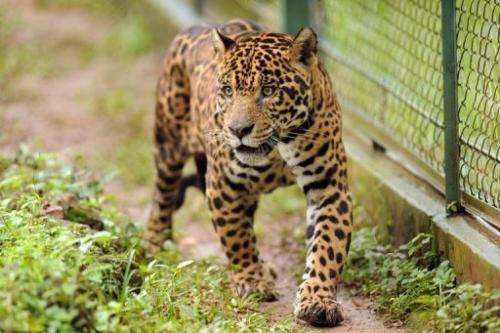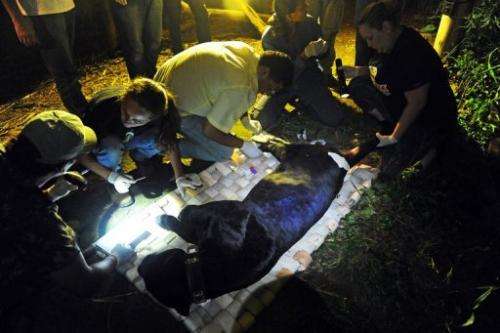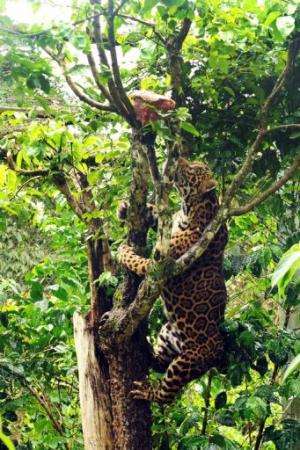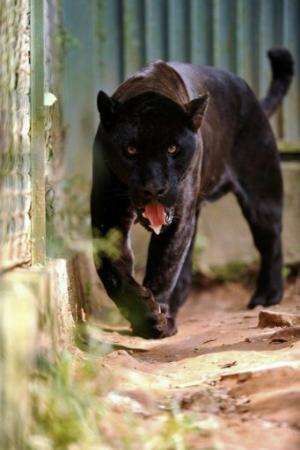Mission to save jaguar exposes big cats' plight in Brazil

It was late at night at the Preto Velho ranch when the unsuspecting jaguar approached the trap, took the bait—and was downed by a tranquilizer dart.
This was no common hunting scene, but an experiment aimed at saving the Americas' biggest cat, whose numbers are threatened in Brazil due to soybean crops and livestock encroaching on their natural habitat, especially in the savannah that covers much of central Brazil.
The South American powerhouse, home to around half of all American jaguars, is also home to some who practise the old profession of "oncero", hunter of the "onca pintada," as these animals are called locally.
Preto Velho, 80 kilometers (50 miles) from Brazil's capital, is owned by Cristina Gianni, founder of the Nex (for "No Extinction") conservation group.
For the past 12 years, her land has acted as a sanctuary for the king of the South American jungle—these solitary, nocturnal creatures who can speed across land and water, travelling up to 50 kilometers in a day.
Within hours of being hit with the tranquilizer, and after being fitted with a GPS collar, the 95-kilogram (210-pound) black cat, named Xango, was back awake with a roar that set the ground rumbling, and sent back to his natural habitat.

"Monitoring this animal can be very important to the ecology of the species, since it is becoming extremely scarce in our savannah," said Luiz Alfredo Lopez, environmental analyst for the government's Institute of the Environment (IBAMA), which helped oversee the operation.
Fear of hunters meant the capture and collaring of Xango, under supervision by experts from IBAMA, was kept under tight wraps.
AFP was allowed on the scene, but held to a 30-day embargo on reporting it, to give Xango time to recover and move away, and thus avoid becoming prey to a hunter or a landowner eager to preserve his cattle.
But thanks to the GPS that shows Xango's location, scientists are able to keep watch, learning that he prefers to range in a nearby forest, and allowing them time to warn nearby farmers if he is coming close.
The Nex conservation group said Xango's appearance in the savannah near the capital, which has become increasingly urbanized and where few jaguars roam, was unexpected.

"Finding this wild jaguar in an excellent state of health, just 80 kilometers from Brasilia, has been a great surprise," said Leandro Silveira, president of the Jaguar Conservation Fund, located some 800 kilometers from the Preto Velho ranch, and which provided the GPS collar.
Gianni and her group hope, by tracking Xango closely, it will be able to keep him safe while at the same time allowing him to roam freely—a modified version of what the sanctuary aims to do regularly.
The group's reserve is home to more than 20 cats, including 13 jaguars, a number of whom could not survive in the wild.
Several of them, like one animal called Xico, were raised in a human family—at least while they were small.
Xico slept in a bed and played with dolls in the house "until he began to grow, and his animal instinct awoke, and they had to get rid of him," said Rogerio Silva de Jesus, manager and caretaker of the estate.

The jaguar—like lions, tigers, and leopards—is scientifically classified as a panther, and as with the other large cats, typically requires large areas of unspoiled nature. The species also benefits from a long maturation period, under the care of its mother.
"The mother spends two years teaching the young to hunt and not die. When that is lost, the animal does not survive in the wild," said Gianni.
She admits that "in the vast majority of cases, the reintroduction of large felids to nature has failed, even in Africa."
But Gianni's group is planning to buck the odds. It has three jaguars it hopes to set free, including one whose reinsertion has just been approved by Brazilian authorities.
Fera, a jaguar captured as a juvenile in northern Brazil nearly two years ago, has been raised in a special enclosure, where he was trained to hunt and maintain his aversion to humans.
Perhaps even more importantly, Fera, which means "fierce", seems to have kept his wild spirit despite his upbringing.
"When he came to us as a kid, Fera showed a ferocity as if he had never left the jungle," she said.
"We discovered that his instincts had remained intact, and I promised I would do whatever is possible to return him to nature."
(c) 2013 AFP




















